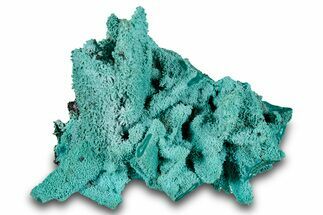This Specimen has been sold.
1.95" Dioptase, Shattuckite & Calcite Association - Tantara Mine, Congo
This is a 1.95" wide association of calcite, light to dark blue shattuckite and dioptase crystals that was collected from the Tantara Mine in the Democratic Republic of Congo.
About Calcite Crystals
Calcite crystals are a form of calcium carbonate (CaCO₃) known for their diverse shapes, transparency, and vibrant range of colors. They typically form in rhombohedral, scalenohedral, or prismatic shapes, often with well-defined, sharp edges and glossy surfaces. Calcite crystals are often translucent or transparent, sometimes displaying a double refraction effect where objects viewed through the crystal appear doubled. They can appear in various colors—white, clear, yellow, pink, blue, green, and orange—depending on impurities or trace minerals.
A notable characteristic of calcite is its reaction with weak acids like vinegar, which causes it to effervesce, or fizz, as it releases carbon dioxide. This property makes calcite crystals a key tool in geological identification and studies. Calcite forms in many environments, from sedimentary rocks like limestone and marble to hydrothermal veins.
Calcite crystals are a form of calcium carbonate (CaCO₃) known for their diverse shapes, transparency, and vibrant range of colors. They typically form in rhombohedral, scalenohedral, or prismatic shapes, often with well-defined, sharp edges and glossy surfaces. Calcite crystals are often translucent or transparent, sometimes displaying a double refraction effect where objects viewed through the crystal appear doubled. They can appear in various colors—white, clear, yellow, pink, blue, green, and orange—depending on impurities or trace minerals.
A notable characteristic of calcite is its reaction with weak acids like vinegar, which causes it to effervesce, or fizz, as it releases carbon dioxide. This property makes calcite crystals a key tool in geological identification and studies. Calcite forms in many environments, from sedimentary rocks like limestone and marble to hydrothermal veins.
Shattuckite is a scarce copper mineral highly regarded for its vivid blue color. It is named after the Shattuck Mine in Bisbee, Arizona, where this mineral was first discovered. It crystallizes in the orthorhombic–dipyramidal crystal system and usually occurs in a granular massive form or as fibrous acicular crystals.
Dioptase is an uncommon mineral, found mostly in desert regions where it forms as a secondary mineral in the oxidized zone of copper sulfide mineral deposits. This copper-based mineral forms small rhombohedral crystals, typically less than 0.75 centimeters in length. It is popular with mineral collectors due to its vibrant color and it is occasionally cut into small emerald-like gems.
SPECIES
Dioptase, Shattuckite & Calcite
LOCATION
Tantara Mine, Shinkolobwe, Katanga Province, DR Congo
SIZE
1.95" wide
CATEGORY
ITEM
#146737
 Reviews
Reviews













